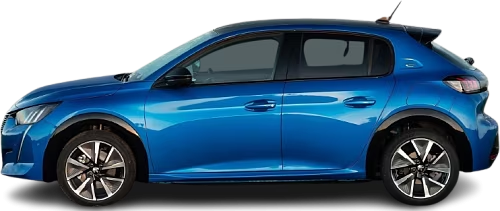USA EV Comparison: Peugeot e-208 50 kWh vs Renault Zoe Z.E. 40 Q90
Struggling to Decide? Let AI Help!
Your AI Summary Is Ready!
General Info
Both vehicles have been discontinued and were never available for sale in the United States.
The two vehicles share the same body style: Hatchback.
| Property | Peugeot e-208 50 kWh | Renault Zoe Z.E. 40 Q90 |
|---|---|---|
| Years of Production | 2021-2023 | 2016-2019 |
| Current Status | Discontinued | Discontinued |
| Country of Manufacture | Slovakia | France |
| Body Style | Hatchback | Hatchback |
| Market Availability | EU | EU |
| GCC Score | 5 | 5.2 |
Range and Efficiency
While the Peugeot e-208 50 kWh (2021-2023) offers a longer real-world range and a bigger battery, it is less energy-efficient than the Renault Zoe Z.E. 40 Q90 (2016-2019).
| Property | Peugeot e-208 50 kWh | Renault Zoe Z.E. 40 Q90 |
|---|---|---|
| Range (WLTP) | 225 mi | - Range (WLTP) |
| Range (GCC) | 193 mi | 173 mi |
| Battery Capacity (Nominal) | 50 kWh | 44.1 kWh |
| Battery Capacity (Usable) | 46.3 kWh | 41 kWh |
| Efficiency per 100 mi | 24 kWh/100 mi | 23.7 kWh/100 mi |
| Efficiency per kWh | 4.17 mi/kWh | 4.22 mi/kWh |
| Range and Efficiency Score | 6.7 | 6.4 |
Charging
Both vehicles utilize a standard 400-volt architecture.
The Renault Zoe Z.E. 40 Q90 (2016-2019) has no DC fast charging capability, whereas the Peugeot e-208 50 kWh (2021-2023) can charge at up to 101 kW.
The Renault Zoe Z.E. 40 Q90 (2016-2019) features a more powerful on-board charger, supporting a maximum AC charging power of 43 kW, whereas the Peugeot e-208 50 kWh (2021-2023) is limited to 7.4 kW.
| Property | Peugeot e-208 50 kWh | Renault Zoe Z.E. 40 Q90 |
|---|---|---|
| Max Charging Power (AC) | 7.4 kW | 43 kW |
| Max Charging Power (DC) | 101 kW | - Max Charging Power (DC) |
| Architecture | 400 V | 400 V |
| Charge Port | CCS Type 2 | Type 2 (Mennekes) |
| Charging Score | 4.3 | 6.2 |
Performance
Both vehicles are front-wheel drive.
The Peugeot e-208 50 kWh (2021-2023) boasts greater motor power and accelerates faster from 0 to 60 mph.
| Property | Peugeot e-208 50 kWh | Renault Zoe Z.E. 40 Q90 |
|---|---|---|
| Drive Type | FWD | FWD |
| Motor Type | PMSM | PMSM |
| Motor Power (kW) | 100 kW | 65 kW |
| Motor Power (hp) | 134 hp | 87 hp |
| Motor Torque | 192 lb-ft | 162 lb-ft |
| 0-60 mph | 8.6 s | 12.7 s |
| Top Speed | 93 mph | 84 mph |
| Performance Score | 2.8 | 1.7 |
Dimensions
The Peugeot e-208 50 kWh (2021-2023) has a wider body, offering a more shoulder room, while the Renault Zoe Z.E. 40 Q90 (2016-2019) stands taller for a more elevated driving position. Despite these differences, their lengths are nearly identical.
Both models have similar wheelbase lengths.
| Property | Peugeot e-208 50 kWh | Renault Zoe Z.E. 40 Q90 |
|---|---|---|
| Length | 159.6 in | 160.8 in |
| Width (with Mirrors) | 77.2 in | 76.6 in |
| Width (w/o Mirrors) | 69.5 in | 68.1 in |
| Height | 56.3 in | 61.5 in |
| Wheelbase | 100 in | 101.9 in |
Cargo and Towing
The Renault Zoe Z.E. 40 Q90 (2016-2019) provides more cargo capacity, featuring both a larger trunk and more space with the rear seats folded.
Neither car is equipped with a frunk (front trunk).
Neither vehicle is officially rated for towing in the US.
| Property | Peugeot e-208 50 kWh | Renault Zoe Z.E. 40 Q90 |
|---|---|---|
| Number of Seats | 5 | 5 |
| Curb Weight | 3373 lb | 3263 lb |
| Cargo Volume (Trunk) | 9.4 ft3 | 11.9 ft3 |
| Cargo Volume (Max) | 39.1 ft3 | 43.3 ft3 |
| Cargo Volume (Frunk) | - Cargo Volume (Frunk) | - Cargo Volume (Frunk) |
| Towing Capacity | - Towing Capacity | - Towing Capacity |
| Cargo and Towing Score | 3.5 | 4.2 |




